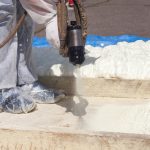Automotive Polyurethane Foams Have Countless Capabilities
Automotive polyurethane foams have been used for several decades throughout the automotive industry, and they continue to be crucial materials for various applications. These foams are known for their excellent insulation, cushioning, and acoustic properties, making them ideal for use in a wide range of automotive components. Here, we’ll take a closer look at these foams and their uses within the industry.
What are Polyurethane Foams?
Polyurethane foam is a versatile and lightweight material made by combining two main components: a polyol and an isocyanate. These two components react chemically, and can form either rigid or flexible foam — each having its own unique properties.
Automotive Polyurethane Foams Have Many Uses
Car Seats
Polyurethane foam is an ideal material for car seats due to its excellent cushioning properties. The foam provides a comfortable and supportive surface for drivers and passengers, ensuring a smooth ride even on bumpy roads. It’s also durable and resistant to wear and tear, making it an ideal material for car seats subject to frequent use.
Headrests
Headrests are a crucial safety feature in vehicles, and polyurethane foam plays a critical role in their construction. The foam provides a comfortable surface for the driver’s head to rest while also absorbing shock in the event of an accident.
Dashboards and Door Panels
Polyurethane foam is often used in dashboards and door panels to provide insulation and reduce noise levels inside the car. The foam helps to absorb vibrations and reduce road noise, making the car’s interior quieter and more comfortable for passengers.
How are Automotive Polyurethane Foams Applied?
Polyurethane foam is often created using specialized equipment and mix heads. The combination of equipment and mix heads will be different depending on what you’re trying to achieve. It’s always best to consult with an experienced professional to determine the best combination for your application.
Equipment
High-pressure, low-pressure, gas nucleation, and spray equipment are all popular choices for applying automotive polyurethane foam.
High-pressure equipment delivers chemicals to a gun chamber through heated hoses. When the chemicals find the gun chamber, the two chemicals react with one another, forming polyurethane foam. This equipment is commonly used at elevated temperatures and pressures.
As its name suggests, low-pressure equipment is used when spraying foam at room temperature and low pressure. The chemicals combine in the nozzle chamber, creating the foam.
The gas nucleation process has two different types of equipment; the one you choose will depend on your application process. CO2 gas infusion blending units create a homogenous distribution and dissolution of CO2 into the polyol component of the polyurethane foam. Conversely, dry air/N2 gas infusion blending units offer improved wet ability, mixing quality, material flow, and eliminate surface defects.
Finally, spray equipment pulls the chemical supply from drum pumps or heated day tanks. It offers hydraulic-powered automatic closed-loop control of mixing ratio and flow rate. Additionally, it allows for high-pressure impingement mixing and features chemical pre-heaters and electrically heated hoses to control viscosity.
Mix Heads
L-style, straight-style, and spray-style mix heads are the most popular options to pair with the above dispensing equipment.
L-style mix heads have two mixing chambers that are perpendicular to one another. The chemical counter-impinge in a small horizontal chamber and then are forced into a larger chamber, from where they are distributed.
Straight-style mix heads are precision engineered and ideal for closed-pouring applications that require longer nose lengths to reach the tooling. Like the L-style, this mix head mixes chemicals in chambers and distributes them into molds or via flows.
Spray-style mix heads distribute the material at high pressure onto a surface or part, with the chemicals being delivered to the mix head via heated hoses.
Benefits of Automotive Polyurethane Foams
Lightweight
As a lightweight material, polyurethane foam helps reduce the total weight of the car, which can improve fuel efficiency and reduce emissions.
Durable
Polyurethane foam is extremely resistant to wear and tear. It can withstand frequent use and is less likely to need replacement over time.
Comfortable
Polyurethane foam acts as a cushion, providing a comfortable surface for drivers and passengers.
Insulation
Correct use of polyurethane foam helps reduce noise levels inside the car and improves insulation, making the car more pleasurable to drive.
Rely on Linden for Your Polyurethane Equipment Needs
Linden Polyurethane has been supplying polyurethane equipment to a wide range of industries for decades. Founded in 1985, we are now a world-class designer, engineer, manufacturer, and service provider for standard and custom polyurethane processing machinery.
Since our inception, we’ve pioneered polyurethane innovations and refining tools and equipment used by countless industries through control integration, precision machining, and a relentless approach to continual improvement. We can design and manufacture different types of polyurethane metering, processing, distribution, and storage systems in-house, and we can repair equipment manufactured by other organizations.
Let’s Get Started
Ready to pursue new equipment for your polyurethane needs? Contact us today.





